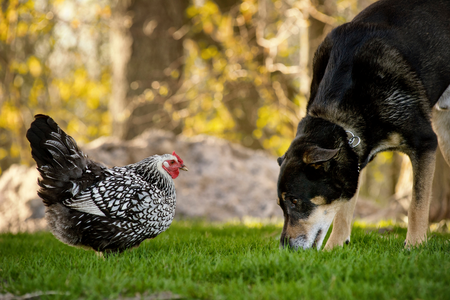
As chicken coops have spread beyond farming communities and across the backyards of modern suburbia, more and more people have found themselves struggling to introduce their pet dogs to their new chickens, or even wondering if they should do it at all.
In this article, we’ll cover the ins and outs of living in harmony with a dog and a flock of chickens.
Should I Introduce Them at All?
This is a common question, usually based around concerns for the safety of the chickens, and on some level, it makes sense. In broad strokes, we tend to think of dogs are predators and chickens as prey, two groups which don’t really mix.
It’s hard to imagine training can be stronger than those base instincts. After all, aren’t they natural enemies?
Actually, not really. Wolves are natural predators, and the red junglefowl from which modern chickens are descended wouldn’t have made a bad prey item for them.
Dogs, however, have had those killer instincts bred out of them for millennia, and your pet lab also won’t have a real motivation to kill your birds, since they are already well-fed.
In fact, some breeds, known as livestock dog breeds, have been bred and trained for centuries to actually embed in herds and protect livestock from exterior threats, i.e., predators.
While they were traditionally used with sheep and goats, a modern resurgence in their popularity has shown them to be just as effective as a full-time guardian of poultry flocks.
Of course, not all breeds have such a reassuring history. If you have a hunting breed, like a setter or terrier, or any dog with a higher prey drive or level of aggression, safely introducing them to a flock of chickens will be trickier. This doesn’t mean it can’t be done, but it may take a little longer to fully acclimate an aggressive or prey-driven dog to your flock.
When Should I Introduce My Dog and My Chickens?
The key principle to keep in mind while introducing a dog to your flock is the idea of acclimation, or slowly getting used to a new situation by easing into it. This will be important for both your chickens and your dog, as throwing them in together right away will almost certainly lead to stress and conflict.
The question of when to introduce them will depend, to a certain extent, on which you had first, and how old they are. Puppies are obviously more volatile and unpredictable than well-trained older dogs, and chicks are much more easily stressed out and frightened than adult hens. However, there’s also something to be said for introducing the two as young as you can, before they’ve learned a routine or any behaviors around dogs or birds that they’ll have to relearn.
In general, after an adoption, try to start introductions as soon as possible after the newcomer has settled into their home. Again, this will be an extended process, so you can always slow down or revert a few steps if needed. After giving the new animals a few weeks for the stress of the move to wear off, though, there isn’t really any reason to delay.
Step by Step: How to Introduce a Dog to Your Chickens
1. Keep everybody happy. Like people, dogs and chickens are much more likely to be open to new relationships or situations if they’re healthy, happy, and well-fed. Don’t make introductions right before dinner, for instance, or both sides will be hungry and cranky and not inclined to be patient. In fact, right after dinner is probably the best time to start this process. Both the flock and the dog will be well-fed, content, and tired.
2. Let them get used to one another from a distance. Put your dog on a lead, and bring them into the yard while the chickens are in their run. Both sides will probably notice the sights, sounds, and smells of the other, and you should let them both investigate this new situation at their own pace. These early meetings can be short, like 10 minutes. Stay at this stage until both animals seem calm and largely unconcerned with each other.
3. Move things in closer. Once your animals can calmly share space from across the yard, you can start slowly bringing them in closer together, moving at whatever pace they set with their comfort levels. Each day, bring your dog a little closer to the coop, then let them sit or walk around on their lead, staying at each distance until they seem unconcerned with the birds. Eventually they should be able to get right next to the run without either your birds or your dog seeming stressed.
4. Let your dog off-lead. This is, in a way, the moment of truth, when you’ll find out if your dog is fully acclimated to your coop or not. A dog that immediately rushes the coop or seems terrified of it will need more on-lead training before they’re ready to be out in the yard on their own. Even if your dog seems calm, someone should always be in the yard with them for at least the first few weeks to ensure the training has fully sunk in.
Despite the concerns many people have, dogs and chickens very much can get along, and introducing them is a slow but simple process that should have them peacefully coexisting in no time.
